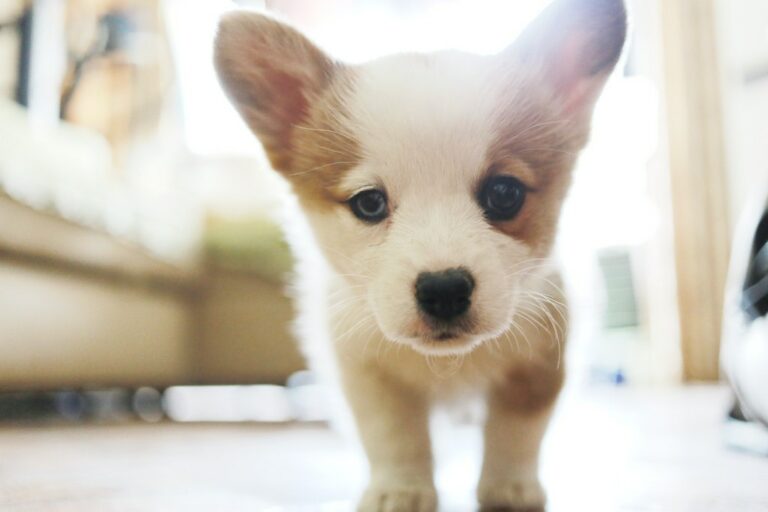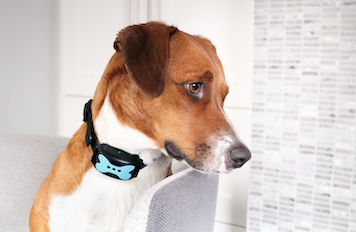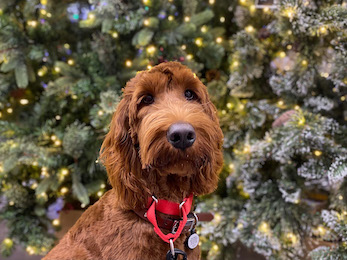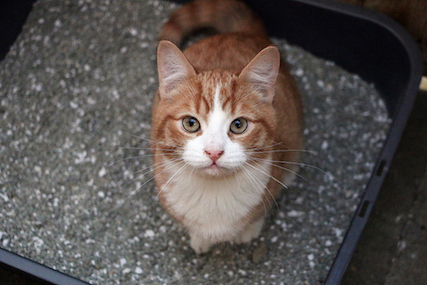Puppies learn through the same processes as you—classical and operant conditioning!
Classical conditioning involves creating associations between events and experiences. For example, if your puppy has a great experience when they interact with children, they will likely learn that kids are a source of rich, positive experiences and will likely seek them out in the future. Conversely, if a puppy has an unpleasant experience when they interact with kids, they will learn that kids are a source of painful or unpleasant experiences and will likely begin avoiding kids. The same can be said for veterinarians, other dogs, cats, thunderstorms, cars, new parks, or stores…the list could go on!
How Puppies Learn Through Classical Conditioning
As a pet parent or trainer, it’s important to know how to use classical conditioning to your advantage. I recommend you control the interaction so you can more reliably predict the outcome. After all, your puppy will have an experience one way or another and it’s important it goes in the direction that will help shape a friendly, confident, and calm adult dog. By controlling the interactions your puppy has, you can more reliably control what type of dog they will be in the future!
Using Classical Conditioning to Your Advantage
Before getting your puppy, consider the environment from which they are coming. For more information about ideal conditions for puppy raising, check out my blog, “Bringing Puppy Home”. Once you get your puppy, use classical conditioning, pairing pleasant things with the presence of anything new or the slightest bit scary. One of the easiest ways to do this is by feeding your puppy small, tasty treats around anything new or scary. Take them to a variety of new and different places with new sights and smells, making sure to specifically cover places you plan to take them as an adult.
While it’s important that your puppy can tolerate new and different places with new and different sights, sounds, and smells, it’s critical they are friendly and remain friendly to both dogs and humans. To ensure your puppy grows into an adult dog that is friendly to both dogs and humans, I encourage you to have them see (and ideally interact) with 20 new people and 20 new friendly and vaccinated dogs per week. It might be difficult to target that number of dogs. If that’s the case for you, I recommend going to a local park and, at a minimum allowing them to see other dogs at a distance. Please keep in mind that your puppy won’t be fully vaccinated so it’s important to balance those risks.
By using classical conditioning to your advantage, you can more reliably predict that your puppy will grow into a well-adjusted, friendly dog. Want obedience and manners too? Read on to see another way in which puppies learn!
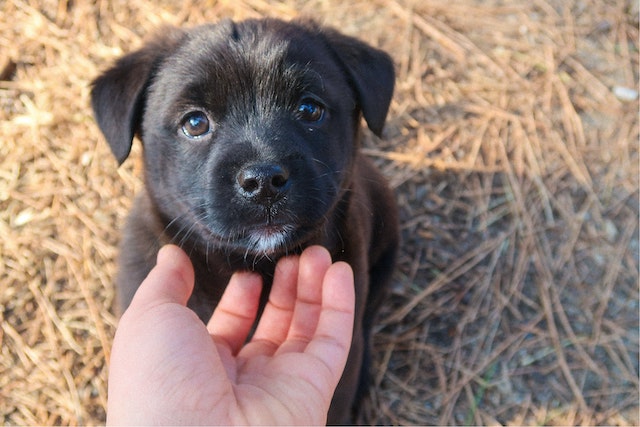
How Puppies Learn Through Operant Conditioning
Operant conditioning is the process by which future behavior changes because of what is applied or removed following a behavior—in other words, consequences. Future behavior is either strengthened or weakened. When behavior is strengthened it has been reinforced. When a behavior weakens it has been punished. For example, consider your puppy jumping and receiving petting. If jumping increases in the future, petting has served as a reinforcer for jumping. If jumping doesn’t increase in the future, the petting did not serve as a reinforcer. Alternatively, consider your puppy chasing a bee and getting stung in the process. If chasing bees decreases because of the sting, the chasing has been punished by the sting. If chasing doesn’t decrease, the sting cannot be considered a punisher because it did not have that effect on behavior.
Using operant conditioning to your advantage
Just like with classical conditioning, it’s important to understand what is controlling your puppy’s behavior. By understanding that the environment affects behavior (even if you’re not around), you’ll be able to control more of what influences your puppy’s behavior because you’ll control more of their learning history.
How Puppies Learn Manners in Your Home
As soon as your puppy enters your home (and before) their behavior will be shaped by consequences. Before your puppy begins getting into trouble, start using positive reinforcement to teach behaviors you want to increase. Think beyond obedience behaviors (e.g., sit, down, heel, and go to your place) and start by targeting common problem behaviors. You can start teaching behaviors that directly compete with problem behavior which significantly reduces, and in some cases, completely avoids some inappropriate behavior. Begin teaching your puppy to potty outside, chew on toys, and sit for attention because those behaviors will directly compete with house soiling, chewing, play biting, and jumping, respectively. It’s an easy way to use positive reinforcement to your advantage! For more specific information on teaching those behaviors check out my “Bringing Puppy Home,” blog.
How Puppies Learn Obedience Behaviors
I recommend making socialization and manners your top priorities with your new puppy. Once those are underway and around 10-12 weeks, I recommend starting obedience training. Using positive reinforcement, you might be surprised just how quickly your puppy learns a new command.
Using Meals as a Reinforcer During Obedience Training
I like to use a puppy’s meal, kibble by kibble, as a reinforcer. There are a lot of benefits to using your puppy’s meal as a reinforcer. They include:
- There are a lot of individual pieces of kibble in one serving of a puppy’s meal. This gives you plenty of opportunities to teach your puppy the new obedience behavior and ensures a lot of repetition.
- Pieces of kibble are generally small (if not, I suggest buying the same type but in small bites). When the reinforcer is small, it can be consumed quickly which is important when teaching new obedience behaviors. This allows you to keep a fast pace during training.
- If you’re able to use your puppy’s meals for standard obedience behaviors, you’ll be able to rely on tastier treats when a behavior is more challenging for your puppy. Challenging behaviors, which differ for every puppy, should be “paid” with a tastier treat. Using kibble as a standard gives you plenty of room to move up the value scale.
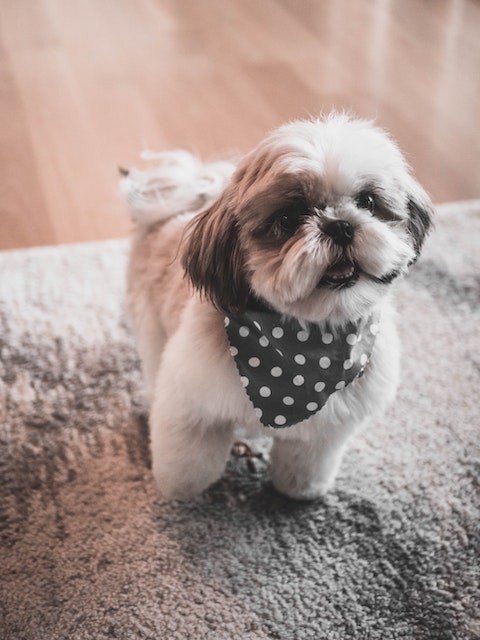
Training Environment
When you start teaching your puppy obedience behaviors the training environment must be free of distractions. I recommend starting indoors in an area your puppy spends a lot of time. This is generally the main living space of the house. Other people and pets should not be present. Your puppy should be pottied and full of energy. A tired puppy is difficult to train! I recommend having your puppy drag a leash in case they begin wandering off during the training session. Another aspect to consider in the training environment is the flooring. Puppies generally perform better with a soft surface under them. Starting on a rug or carpeted space reduces effort initially in training but will need to be faded quickly and within a day or two.
Communicating with Precision
It’s important to communicate with precision when teaching your puppy a new skill. To help with that communication, I recommend using a bridge word. A bridge word simply bridges the gap between the time your puppy does the behavior you want and the time you can deliver a reinforcer. A bridge should be a short word said in a concise, happy tone and is reliably paired with a treat. I like to use the word, “good.” Bridge the moment you want to reward, and then, deliver the food later (still within a few seconds).
When delivering the reinforcer, it’s important to consider what behavior is happening at that moment. For that reason, I instruct clients and trainers to deliver the food when the dog is in position rather than once they come out of the position. It’s important that you remain in control of the piece of kibble until it is in your puppy’s mouth. That way, if your puppy gets out of position, you can remove the food until they are back in position. This will teach them precisely what you want. Release them after you feed.
Using a Food Lure
Several obedience behaviors can start with a food lure. When you use a food lure you have a piece of food in your hand, and you guide your puppy into position as they follow the food around. There should be no forced contact or physical guidance other than your puppy following your hand. Consider the command, “sit.” Start with one piece of kibble in your right hand and the remainder of the meal in a treat bag behind your back. Get your puppy’s attention by showing them the food that is placed within the tips of your fingers. As your puppy becomes interested in the kibble, guide your hand slowly over their head and between their eyes. As their eyes begin moving towards the ceiling and their head cocks back, they will sit. As soon as their bottom touches the ground, bridge (“good”), and deliver a treat quickly. Then provide a release like, “okay” or “free”. By using a food lure, you’ve successfully started the sit command. Down, leash walking, and ‘go to your place,’ can all be taught in the same way.
Pace of Training When Using a Food Lure
When using a food lure to teach your puppy a command, it’s important to consider how fast you (and your puppy) complete the command. The faster you can do repetitions of the single command, the faster your puppy will learn! Try luring, getting your puppy into the position, bridging, feeding, and releasing as fast as possible. I encourage you to time yourself and stay very focused for 1-minute intervals. Focus on repetitions of the same behavior over and over. Your goal is 6 repetitions of one command in 1 minute. For example, set your timer for 1 minute and get your puppy to sit 6 times within that 1 minute. I also recommend starting with a behavior that is low in effort (e.g., sit) at the start of the training session.
Fading the Food Lure to a Hand Signal
Once you’ve reliably established a food lure, it’s time to begin fading that food lure to a hand signal. The hand signal will be the same motion as the lure, but there won’t be food in the hand signal hand. For most behaviors, this can be done during the first or second training session. With the pace of training described above, start by tricking your puppy. Sometimes those squishy puppies are smarter than you think so you’ll need to be slick! While still using food in your luring hand (soon to become hand signal hand), begin using what you envision as your hand signal. In other words, modify your lure to look like a hand signal. Keep the food in that same hand as you modify the lure. I’ve listed some examples below. After a few successful trials, have a handful of treats in your non-luring hand and start feeding the reward out of that hand. In other words, lure with one hand, get your puppy into position, bridge (“good”), and treat with the opposite hand. This will get your puppy used to not eating out of the lure/hand signal hand, tolerating just a small delay in feeding, and getting them used to the food coming from the opposite hand. Once you are in a rhythm and when your puppy is released from command, immediately get their attention, and use a hand signal (same motion you’ve been using but without food in the hand signal hand). Continue a few more times, rapidly presenting the hand signal to keep their focus. Boom! You have successfully faded the lure to a hand signal! I recommend starting with sit because it is the simplest command to fade from a lure to a hand signal.
- Sit: Open hand with your palm facing the sky, moving your hand to the sky.
- Down: Open hand with your palm facing the ground, moving your hand to the ground.
- Place: Pointed index finger moving towards the bed.
- Heel: Left arm straight on the left side of your body. As your puppy follows the treat bring your left hand to your chest by bending your elbow. Soon after, your movement as you walk becomes the signal for heel.
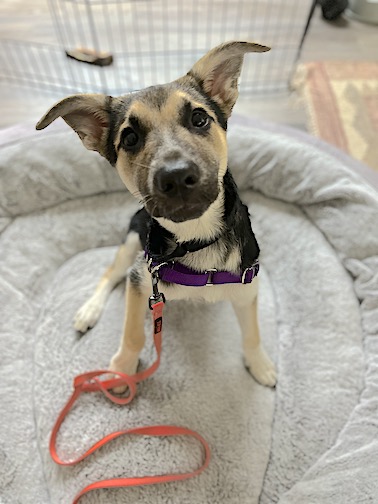
Shaping Duration Behaviors
For behaviors like “stay,” I recommend starting with your puppy in a sit or down position (select the command they know best) and continue rewarding as long as they maintain the position. When you start, bridge and feed quickly with less than 1 second between treats. Be sure to stay in the same position to avoid distracting your puppy. As your puppy is successful begin slowing your rate of feeding. After 5 treats or so, release (“free”) and repeat. Continue slowing down the rate of feeding. If your puppy gets up before you release them, simply put them back in the general vicinity and give them the hand signal without rewarding them. Once you’ve faded the rate of feeding to about every 3 seconds, you can begin moving your feet in place. Continue rewarding intermittently, focusing on times that are most difficult for your puppy. Start moving around, always bridging at the most challenging times. Return to your puppy to deliver the food rather than calling them out of the stay command.
These are just a few of the manners and obedience behaviors your puppy can learn. With just a simple understanding of operant conditioning and some insight into some easy tricks Beyond the Dog has developed over the past 20 years, you’ll be well on your way to teaching your puppy the basic skills necessary to be a well-mannered and obedient adult dog.
Intertwined Classical and Operant Conditioning
The beauty of using positive reinforcement when teaching manners and obedience behaviors to your puppy is that you can gain the benefits of the process of classical conditioning as well. In some ways, you are getting twice the bang for your effort buck! Strengthening behavior with the use of positive reinforcement also ties nearly everything within those training sessions with something positive. Consider everything that takes place or is present in your puppy’s training sessions— learning, obedience, complying with your commands, the space you’re training in, and, maybe most importantly, you! All of those “things” get classically conditioned and become a (greater) source of joy for your puppy. Imagine the bond you’ll develop as you take part in teaching your puppy a lifelong love of learning.
